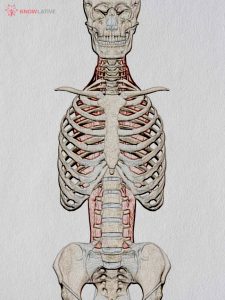The muscles of the back can be divided into three groups – superficial, intermediate and intrinsic:
- Superficial: associated with movements of the shoulder.
- Intermediate: associated with movements of the thoracic cage.
- Deep: associated with movements of the vertebral column.
The deep muscles develop embryologically in the back, and are thus described as intrinsic muscles. The superficial and intermediate muscles do not develop in the back, and are classified as extrinsic muscles.
The deep muscles of the back are well-developed, and collectively extend from the sacrum to the base of the skull. They are associated with the movements of the vertebral column, and the control of posture. The muscles themselves are covered by deep fascia, which plays a key role in their organization.
Anatomically, the deep back (intrinsic) muscles can be divided into three layers:
Superficial layer
The superficial muscles are also known as the Spinotransversales. There are two muscles in this group: Splenius Capitis and Splenius Cervicis. They are both associated with movements of the head and neck. They are located on the posterolateral aspect of the neck, covering the deeper neck muscles.
Intermediate layer
There are three intermediate intrinsic back muscles: the Iliocostalis, Longissimus and Spinalis. Together these muscles form a column, known as the Sacrospinalis – Erector Spinae. The Sacrospinalis – Erector Spinae is situated posterolaterally to spinal column, between the vertebral spinous processes and the costal angle of the ribs. All three muscles have a common tendinous origin, which arises from: Lumbar and lower thoracic vertebrae, Sacrum, Posterior aspect of iliac crest, Sacroiliac and supraspinous ligaments.
Deep layer
The deep intrinsic muscles are located underneath the erector spinae. They are a group of short muscles, associated with the transverse and spinous processes of the vertebral column.
- There are three major muscles known collectively as the Transversospinalis: the Semispinalis, Multifidus and Rotatores.
- And two Minor groups: Interspinales (that some authors consider part of the Transversospinalis) and Intertransversarii.

